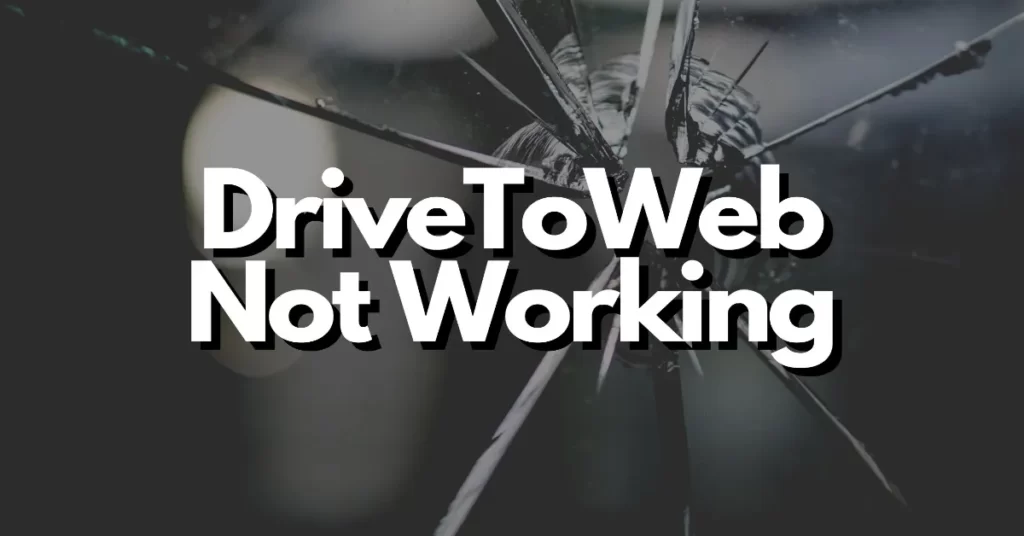Encountering technical issues with online services can be frustrating, especially when they hinder your ability to publish or access your website. If you’re experiencing difficulties with Drive to Web, a service that converts Google Drive documents into websites, it’s essential to identify potential causes and troubleshooting steps.
In this blog post, we will explore common reasons why Drive to Web may not be working, providing insights and solutions to help you resolve the issue and get your website up and running smoothly again.
Troubleshooting Drive to Web: Common Issues and Solutions:
While Drive to Web services offer convenience, you may encounter common issues that require troubleshooting. One common issue is the incorrect display of files due to browser caching. To resolve this, clear your browser cache or use the “incognito” mode to load the website without cached files.
Another issue is the incorrect MIME type detection for certain file formats. Adjusting the MIME type settings within the cloud storage platform or adding a configuration file can address this problem. Additionally, ensure that your website files are correctly shared and have the appropriate permissions set.
If you encounter issues with accessing your website, double-check the sharing settings and permissions. By understanding these common issues and applying the recommended solutions, you can effectively troubleshoot Drive to Web problems.
Understanding Possible Causes of Drive to Web Malfunction:
Drive to Web services rely on the integration between your cloud storage platform and the hosting mechanism. Several factors can contribute to malfunctions or unexpected behavior.
Network connectivity issues, such as a loss of internet connection or server downtime on the cloud storage platform’s side, can disrupt the hosting process. Incompatibility between the cloud storage platform and certain website features or coding techniques may also cause malfunctions.
Lastly, errors in file sharing settings or incorrect configurations within the cloud storage account can lead to unexpected behavior. Understanding these possible causes can help identify and resolve issues more effectively when using Drive to Web services.
Tips for Resolving Drive to Web Problems: Step-by-Step Guide:
When faced with problems while using Drive to Web services, it’s important to follow a systematic approach for resolution. Start by checking your internet connectivity to ensure a stable connection. Next, verify the sharing settings and permissions for your website files, making sure they are correctly set.
Clear your browser cache to eliminate potential caching issues. If the problem persists, try accessing your website from a different browser or device to rule out any browser-specific issues. Contact the cloud storage platform’s customer support for assistance if the problem is related to server downtime or technical issues on their end.
By following these step-by-step tips, you can troubleshoot and resolve Drive to Web problems effectively.
Seeking Technical Support for Drive to Web Issues: Contacting Customer Service:
When encountering technical issues with Drive to Web services that you’re unable to resolve on your own, seeking technical support from the cloud storage platform’s customer service is the next course of action. Most cloud storage providers offer customer support through various channels, such as email, live chat, or phone.
Before reaching out, document the issue you’re facing, including any error messages or relevant details. Provide clear and concise information when contacting customer service, outlining the steps you’ve already taken to troubleshoot the problem. Be prepared to provide account details and any necessary verification information.
Customer service representatives can assist you in diagnosing the issue and providing specific guidance to resolve the problem effectively.
Conclusion
In conclusion, encountering issues with Drive to Web can be due to various factors, including connectivity problems, file format compatibility, or limitations within the service itself. By following the troubleshooting steps outlined in this article, you can pinpoint the cause of the problem and take appropriate actions to resolve it.
However, if the issues persist or you require advanced features not supported by Drive to Web, it may be worth exploring alternative website hosting solutions or consulting with technical support for further assistance. Remember to regularly back up your files and have contingency plans in place to mitigate any potential disruptions to your online presence.
